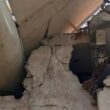A month after the tragic Air India Dreamliner crash in Ahmedabad that claimed over 270 lives, a preliminary investigation report has revealed chilling details from the final moments inside the cockpit—indicating a possible unintentional fuel cutoff moments after takeoff.
According to the Aircraft Accident Investigation Bureau (AAIB), data from the Enhanced Airborne Flight Recorder (EAFR) shows that both engine fuel control switches were moved from ‘RUN’ to ‘CUTOFF’, effectively shutting off fuel supply to the Boeing 787-8 aircraft. The reason for this transition remains unclear, but cockpit voice recordings captured a tense exchange:
“Why did you cut off?” one pilot asked.
“I didn’t,” the other replied.
Seconds later, the crew attempted to recover by switching the fuel controls back to ‘RUN’, triggering the engine’s automatic relight and thrust recovery system, according to Boeing’s engine specifications. However, the aircraft lost altitude rapidly and crashed just 32 seconds after takeoff, before the engines could fully recover.
Tragedy Unfolds in Seconds
The London-bound flight, fully loaded with fuel, plunged into a nearby medical students’ hostel, killing almost everyone on board, including both pilots—Captain Sumeet Sabharwal (8,200 flying hours) and First Officer Clive Kundar (1,100 flying hours)—as well as around 30 people on the ground. Only one survivor has been reported.
Shortly before impact, one of the pilots issued a MAYDAY call, but Air Traffic Control (ATC) received no further response. CCTV footage confirmed deployment of the Ram Air Turbine (RAT)—an emergency mechanism triggered by complete engine or electrical failure—suggesting an immediate and catastrophic systems collapse.
Investigators Probe Potential Technical Fault
While there is no evidence of sabotage, the report cites a Federal Aviation Administration (FAA) bulletin highlighting concerns over fuel control switches on Boeing aircraft being installed with the locking feature disengaged. Though not officially classified as a flight safety hazard, the issue remains under scrutiny.
“No significant bird activity was observed, and weather conditions were normal,” the AAIB report adds. The aircraft failed to gain enough altitude before breaching the perimeter wall of the airport.
Echoes of Past Incidents
A similar fuel-cutoff error occurred in the 1980s when a Delta Airlines pilot accidentally shut off both engines of a Boeing 767 but managed to restart them mid-air, narrowly averting disaster. In this case, the Air India aircraft was too close to the ground to recover.
The crash marks one of the deadliest aviation tragedies in India in recent decades and has sparked renewed concerns over cockpit procedures, switch safety mechanisms, and pilot training in high-stress scenarios.
The AAIB has said a full investigation is ongoing and urged restraint from speculation until all data is analyzed.











